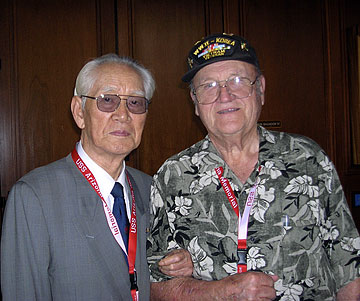
PHOTO BY MITCH MOORE
Zero pilot Takeshi Maeda and P-51 pilot Gordon Scott share memories of the air war in the Pacific. CLICK FOR LARGE
|
|
WWII adversaries work to raise ditched P-51 plane
By Mitch Moore
Special to the Star-Bulletin
Editor's note: Freelance writer Mitch Moore accompanied his grandfather, Gordon Scott, a World War II veteran, to Oahu last week to attend the 65th anniversary of the Pearl Harbor attacks.
THEY ONCE swarmed the skies and shot at each other. They dropped bombs and launched torpedoes. The United States and Japan were at war, and these young men had answered the call to serve their country.
Sixty-five years later, Japanese and American WWII pilots from the Pacific met in Honolulu on the 65th Anniversary of Pearl Harbor, humble and grateful old men in the twilight of their lives. Now they recognize in each other not the enemy, but simply a fellow aviator, eager to shake hands, swap business cards and tell stories.
"We're part of a very small fraternity, part of the aviator group, whether we're pilots or navigators, and there's a certain solidarity between us," said Takeshi Maeda, a torpedo gunner who helped sink the Pearl Harbor battleship West Virginia. "We're a small and close-knit group, so when we lose one of our brethren, such as the one that went down in Kasamigura, we want to spend all our efforts looking for our fallen comrade and see if we can pluck them from the sea."
THE BRETHREN Maeda speaks of is my grandfather, Gordon Scott, then a 22 year-old first lieutenant who was shot down in his P-51 Mustang fighter July 4, 1945, after strafing and fire-bombing an aircraft production facility on the Japanese mainland.
Scott survived the crash into Lake Kasamigura and narrowly escaped the cockpit before his plane plunged to the bottom of the lake. But the fighter remains, probably buried in several feel of silt and likely still intact.
Mark Stevens, historian for the Air Force's veteran 7th Fighter Command Association, seeks permission from the Japanese government to search for and recover the plane. He says it's the only P-51 left in the world that flew in the Pacific.
Stevens, an avionics engineering manager for Boeing in Seattle, plans to donate the plane to a museum. Most of all he wants to "see the look on Gordon's face" when his fighter is pulled out of the lake.
Stevens is soliciting the aid of Zero pilots Zenji Abe, Jiro Yoshida and Maeda in obtaining permits to recover the plane. He has commitments from a Seattle nonprofit oceanographic firm to donate their time for the project.
"It's a natural thing to have this ... mutual reliance," Maeda said. "That's why when one of us is lost I feel we should use everything we can to find the plane."
However, a strain of herpes is affecting koi fish in the lake, said Maeda, and the Japan fisheries ministry is reluctant to allow any kind of activity that might further poison the lake and endanger the fish.
"We are working as hard as we can to get the permission," Maeda said. "We still need to push hard, but without fail we will find it."
AFTER DISENTANGLING himself from his parachute and life raft, Scott swam more than four hours to reach a distant shore. He was hiding among some marsh reeds when he was spotted by a Japanese fisherman and his son. They alerted nearby villagers, who were waiting for him when he reached the shore.
After an impromptu trial in the village schoolhouse, Scott was tied to a cherry tree and about to be shot by a firing squad wielding rusty, antique rifles. A burlap rice sack covered his head as he said a prayer for his wife, Patricia, and his 3-month-old daughter, Colleen (my mother), whom he had not yet seen.
Along came a Japanese army squad in a convertible, wood-burning car. He was set atop the back of the convertible and paraded through the countryside before being taken to Kempe Tai prison in Tokyo, next to the emperor's palace. There he was held prisoner and interrogated until the end of the war.
Scott went on to serve 30 years in the Air Force, flying combat missions in Korea and Vietnam. A lifelong aviator, Scott gave up his pilot's license in 2002 at the age of 80, after completing a solo trip around the perimeter of the mainland U.S. in his Cessna 152 single-engine airplane.
Now, he hopes to see that aircraft from so many years ago once again.
"I'd like to see the plane raised up and put on display so that anybody who flew a P-51 or a mechanic who kept them flying can see it and tell a story about it. No brag. Just fact," he said.

